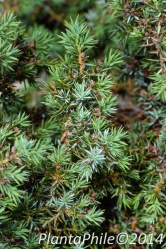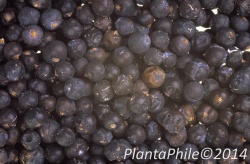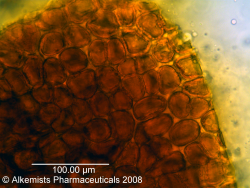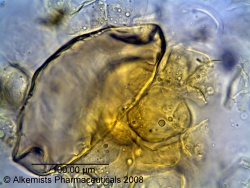|
AHPA recognizes other valuable resources exist regarding the identity of Juniperus communis.
To submit a suggestion or contribution, please contact Merle Zimmermann.
|
Nomenclature
Juniperus communis L. Cupressaceae
Standardized common name (English): juniper
Ayurvedic name(s): hapusha
Botanical Voucher Specimen
 |
|
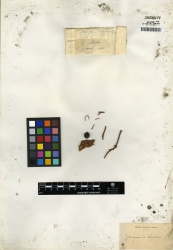
Source: MOBOT, Tropicos.org[1]
|
Organoleptic Characteristics
[Juniperus communis (fruit) have an ...] aromatic odor; taste sweet, pleasant, terebinthinate, slightly bitter.
Source: United States Dispensatory (1918) [2]
|
|
|
|
|
Macroscopic Characteristics
| [Juniperus communis (fruit)] are nearly globular, about 8 mm. in diameter; externally smooth, shining, black-brown to purplish-black with a blue-gray bloom, at the apex a three-rayed furrow marks the cohesion of the three fleshy bracta forming the pericarp; internally loosely fleshy, greenish-brown, containing numerous large schizogenous cavities; seeds three, triangular ovate, hard, brown, with large uneven oil glands on the surface.
Source: United States Dispensatory (1918) [3]
|
|
|
|
|
Microscopic Characteristics
| Sections, when examined under the microscope, exhibit a pericarp consisting of an epiderm of a single row of rounded polygonal cells filled with a brown granular substance, at the sutures of the bracts these become blunt papillae; a hypodermis of two or three rows or brown-red, collenchymatous cells thickened at the angles; the fleshy portion (mesophyl) composed of loose, irregular parenchyma with large oval canals and traversed by fibro-vascular bundles with areolated fibers; a sclerenchymatous ring of six to eight rows of very thick cells with pitted walls, many enclosing prismatic crystals of calcium oxalate; the seed-testa shows a layer of two to ten rows of stone cells with radial markings on the walls and each enclosing a polygonal crystal of calcium oxalate; endosperm and embryo rich in fat and aleurone.
Source: United States Dispensatory (1918) [6]
|
|
|
|
|
High Performance Thin Layer Chromatographic Identification
Supplementary Information
Sources
- ↑ MOBOT, Tropicos.org http://www.tropicos.org/Image/100130123
- ↑ United States Dispensatory (1918)
- ↑ United States Dispensatory (1918)
- ↑ PlantaPhile http://plantaphile.com/
- ↑ PlantaPhile http://plantaphile.com/
- ↑ United States Dispensatory (1918)
- ↑ Elan M. Sudberg, Alkemist Laboratories http://www.alkemist.com
- ↑ Elan M. Sudberg, Alkemist Laboratories http://www.alkemist.com

